The Best Kitchen Layouts for Every Style and Size
Key Points Optimizing your kitchen layout enhances both functionality and style, catering to the multifaceted uses of modern kitchens, from cooking...
6 min read
.png) Ranney Blair
:
Oct 19, 2023 2:00:00 PM
Ranney Blair
:
Oct 19, 2023 2:00:00 PM
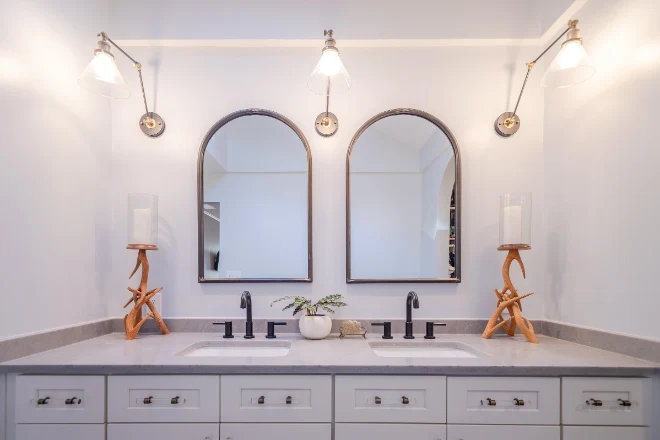
Ever found yourself squinting in the bathroom, trying to apply makeup or shave under inadequate vanity lights?
Or perhaps you've been startled by the harsh glare of an overhead bulb during a midnight trip to the bathroom?
If so, this post is for you.
We're diving deep into the world of LED lighting versus traditional incandescent lighting, specifically for bathroom fixtures.
By the end of this read, you'll not only be enlightened (pun intended) but also equipped with the information to make the best lighting choices for your next bathroom remodeling project in Atlanta.
Let's illuminate the facts on bathroom light fixtures!
Lighting, especially in spaces like the bathroom, is more than just a functional necessity.
It sets the mood, aids in daily routines, and can even influence our perception of space.
In the bustling city of Atlanta, GA, where style meets functionality, the debate between LED and incandescent lighting is hotter than ever.
In the realm of residential lighting, two contenders stand out: LED and incandescent.
Over the years, these two have been the primary choices for homeowners, especially when considering factors like energy consumption, brightness, and cost.
Both have their merits, but as we'll see, one is definitely edging out the other.
.webp?width=660&height=440&name=wall%20sconce%20with%20an%20incandescent%20bulb%20%20in%20a%20bathroom%20(1).webp)
Incandescent bulbs, the classic type of light fixture patented by Thomas Edison, work by heating a filament until it glows.
For years, they've been the go-to for homes across Atlanta and beyond.
However, incandescent light bulbs have recently been banned in favor of more energy-efficient options.
Of course, you can still use the incandescent bulbs you already have, but it's only a matter of time before they disappear from American homes and bathrooms for good.
Fortunately, there's an energy-efficient alternative waiting in the wings.
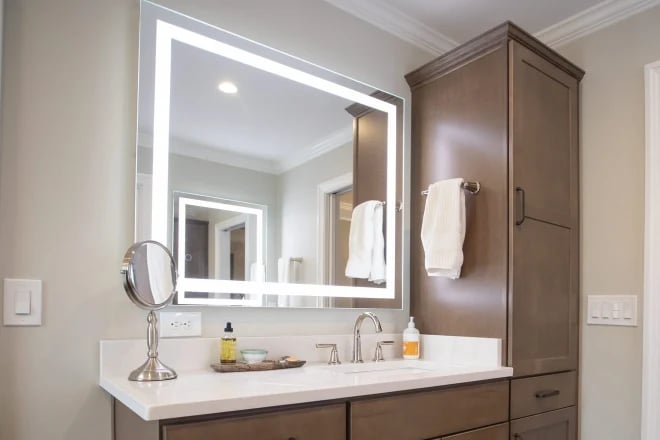
Enter LEDs (light-emitting diodes).
Born in 1962 via the genius of researcher Nick Holonyak, LEDs have come a long way.
They're energy-efficient, durable, and versatile.
With benefits like long lifespan, compatibility with modern tech, and minimal heat generation, it's no wonder LEDs are becoming the preferred choice for many.
Beyond the LED and incandescent duo, other lighting options include fluorescent bulbs, compact fluorescent lamps (CFLs), and gas discharge lights.
Each has its place, but when it comes to efficiency and lifespan, LEDs often come out on top.
Still not ready to jump on the LED bandwagon?
Let's take a closer look at five ways LEDs outshine incandescent bulbs when it comes to bathroom light fixtures.
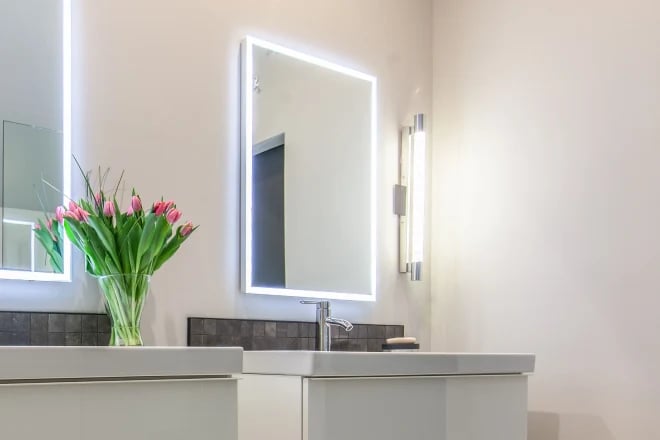
LEDs aren't just for your living room or kitchen; they're making waves in bathroom design, too. Their frosted designs can be particularly appealing.
Here are 5 ways LED bathroom lighting fixtures outshine the competition:
LEDs are directional light maestros.
They don't waste energy scattering light everywhere, which means fewer reflectors and diffusers are needed.
Plus, they consume a whopping 90% less energy than their incandescent counterparts.
For the budget-conscious Atlantan, LEDs are a dream.
They slash electricity bills and, thanks to their durability, reduce the frequency of bulb replacements.
Imagine installing a vanity light and not having to replace it for up to 50,000 hours. That's the LED promise.
In comparison, incandescent bulbs might only last up to 1,000 hours.
LEDs are tiny but mighty.
Their small size means they can fit almost anywhere, giving homeowners and designers unparalleled creative freedom.
Whether you're looking for sconces beside your vanity mirror or overhead bathroom ceiling lights, LEDs have got you covered.
LEDs are known for their safety features.
Unlike some other lighting options, they don't contain hazardous materials like mercury.
This not only makes them environmentally friendly but also safer for household use.
In bathrooms, where moisture and water are prevalent, using LEDs reduces the risk of electrical mishaps due to their low voltage.
Moreover, their cool operation ensures that they won't contribute to heat buildup, making your bathroom experience comfortable and safe.
You can discover other ways of going green in your bathroom here, including water-saving toilet options.
At their core, these two lighting types differ in how they produce light.
Incandescents heat a filament, while LEDs are semiconductor devices that emit light when an electric current passes through them.
Incandescent bulbs have been around for over a century and are known for their warm, cozy light.
Many people appreciate the nostalgic glow they offer, reminiscent of times gone by.
On the other hand, LEDs, or Light Emitting Diodes, are a more recent innovation.
Each has its pros and cons, but as we've seen, LEDs often have the edge, especially in terms of energy efficiency and lifespan.
Let's take a closer look at the pros and cons of each option.
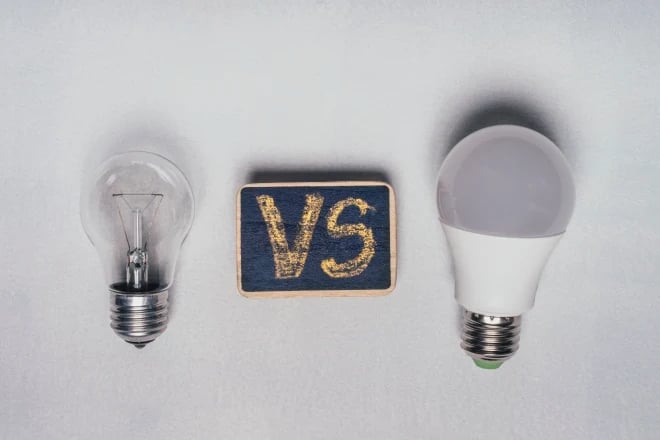
Pros:
Warm Glow: Incandescent bulbs produce a warm and cozy light that many people find appealing.
Immediate Brightness: They light up instantly to full brightness without any warm-up time.
Dimmability: Most incandescent bulbs are easily dimmable, allowing for mood lighting.
Simple Installation: Compatible with most fixtures and don't require special setups.
Cons:
Short Lifespan: Typically last around 1,000 hours, requiring more frequent replacements.
Energy Inefficient: They consume more power, leading to higher electricity bills.
Heat Production: Emit a significant amount of heat, which can be a concern in small bathrooms.
Environmental Concerns: Not as eco-friendly due to higher energy consumption and the use of certain materials.
Pros:
Energy Efficiency: LEDs consume significantly less power, leading to savings on electricity bills.
Long Lifespan: Can last up to 50,000 hours, reducing the need for frequent replacements.
Cool Operation: Emit very little heat, making them safer for enclosed spaces like bathrooms.
Versatility: Available in various color temperatures, from warm to cool, and can be dimmable.
Eco-friendly: Lower energy consumption and lack of hazardous materials make them a green choice.
Cons:
Higher Initial Cost: While prices have decreased, LEDs can still be more expensive upfront than incandescent bulbs. You can learn more about bathroom lighting fixtures cost here.
Dimming Compatibility: Not all LED bulbs are dimmable, and those that are might require specific dimmer switches.
Sensitivity to Temperature: Some LED bulbs may not perform as well in extremely hot or cold conditions. That being said, your bathroom is unlikely to reach those temperature extremes.
Color Consistency: There can be slight variations in color temperature between individual LED bulbs of the same type.
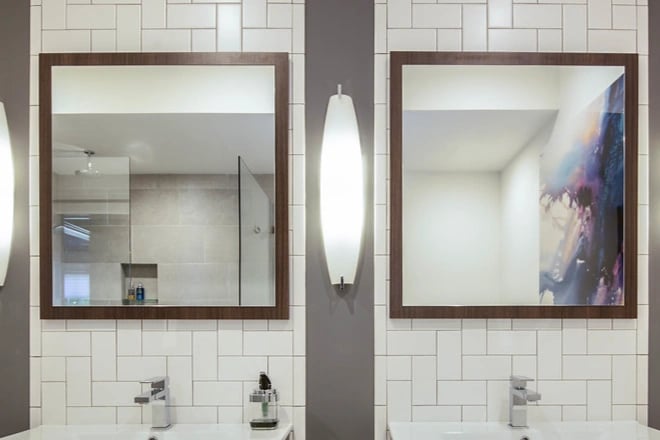
Choosing the right lighting is crucial, especially in a space as functional and intimate as the bathroom.
The bathroom is where we start and end our days, from the morning routine of brushing our teeth and applying makeup to winding down with a relaxing bath in the evening.
The right lighting can enhance these experiences, while the wrong choices can hinder them.
But with the myriad of options available, it's easy to go astray.
For instance, imagine trying to apply makeup or shave under a dim light or being blinded by overly bright lights during a nighttime visit.
Here are some common pitfalls to avoid and tips to ensure your bathroom is illuminated to perfection.
Ever been blinded by bathroom lights in the middle of the night?
Dimmers are the solution, allowing you to adjust brightness to suit the time of day and mood.
CRI can be a tad complex, but in simple terms, it's about how "true" colors look under a light source.
For bathrooms, a natural light range (around 2700k-3000k) is ideal.
Most reputable bulb manufacturers will include the CRI value on the bulb's packaging.
You can also use a light meter or even a mobile app to determine the CRI value.
Too little light, and you're squinting.
Too much, and your bathroom feels like an interrogation room.
The key is layering: combine task, ambient, and accent lighting for the best effect.
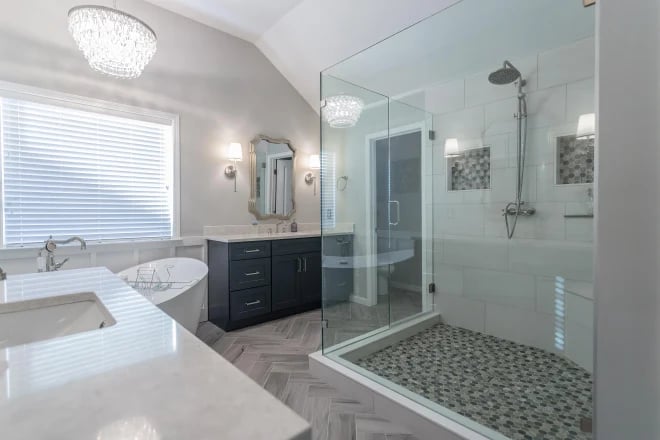
Bathroom vanities are more than just functional spaces; they're often where we prepare ourselves to face the day or wind down for the evening.
The right vanity lights can make all the difference in these routines.
For instance, imagine trying to apply a precise eyeliner or ensuring a clean shave under poor vanity lighting—it can be frustrating and even lead to mishaps.
For those vanity moments, LED lights are the top pick, and here's why:
Damp-Rated: Bathrooms are naturally humid environments, especially after a hot shower or bath. LED vanity lights designed for bathrooms are often "damp-rated," meaning they're specifically designed to handle moisture without shorting out or getting damaged. For example, after a steamy shower, you won't have to worry about the lights flickering or going out due to the moisture in the air.
Warm, Flattering Glow: The color temperature of a bulb can greatly affect how we perceive ourselves in the mirror. LED lights for vanities often come in warm color temperatures, which provide a soft, golden hue. This warm light is flattering for most skin tones, highlighting our features without casting harsh shadows. Think of it as the difference between the soft, golden hour sunlight and the stark, overhead noon sun. The former enhances features and gives a gentle glow, while the latter can exaggerate imperfections.
Energy Efficiency: LED vanity lights consume significantly less energy than traditional incandescent bulbs. So, even if you spend a little extra time perfecting your look, you won't have to worry about a spike in your electricity bill.
Longevity: LED bulbs have a longer lifespan, which means fewer replacements. This is especially handy for bathroom vanity lighting, which is often used multiple times a day.
Versatility in Design: Modern LED vanity lights come in a variety of designs, from classic bulb shapes to sleek, contemporary fixtures. For example, you might opt for vintage-style LED bulbs that mimic the look of old filament bulbs for a retro touch, or choose a minimalist LED strip for a modern aesthetic.
When setting up or upgrading your bathroom vanity, considering the right vanity lighting is crucial.
LED lights, with their myriad of benefits, stand out as the optimal choice for both functionality and ambiance.
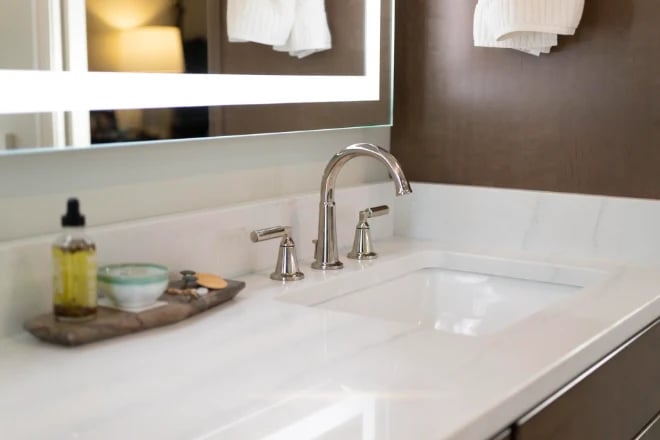
We've shed light on the LED vs. incandescent debate, and the benefits are clear.
If you're in the Atlanta, GA, area, and thinking of a bathroom remodel, Ranney Blair Weidmann has got you covered.
We even have a guide to bathroom remodeling that will help you plan and execute your bathroom remodeling project.
And with our expertise in modern lighting solutions, we'll ensure your bathroom is both functional and stylish.
Ready to brighten up your space?
Fill out our contact form today, or give us a call. Let's make your bathroom shine!
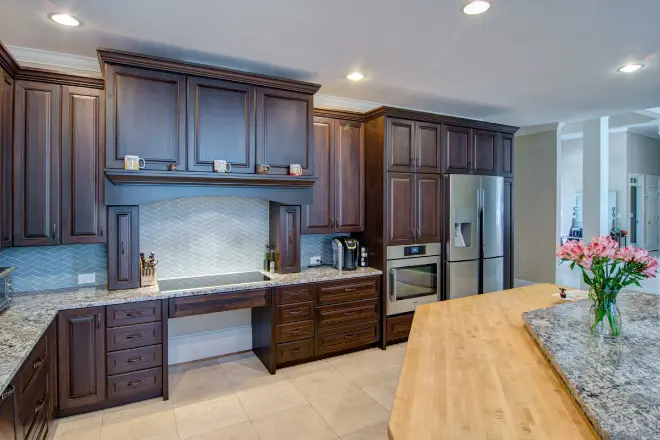
Key Points Optimizing your kitchen layout enhances both functionality and style, catering to the multifaceted uses of modern kitchens, from cooking...
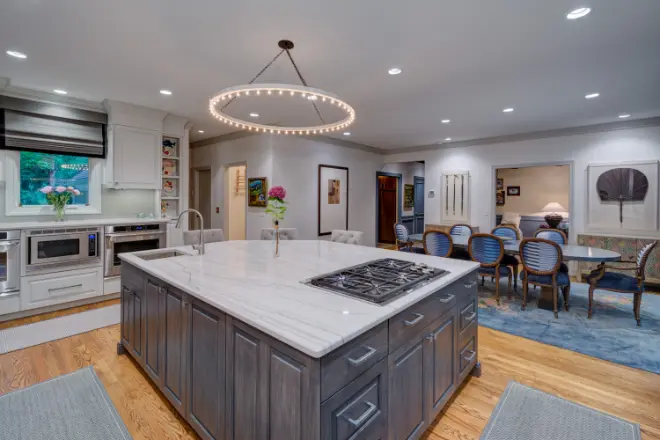
Key Points Open-concept kitchens enhance social interaction, natural light, and flexibility, redefining living experiences by merging kitchen,...
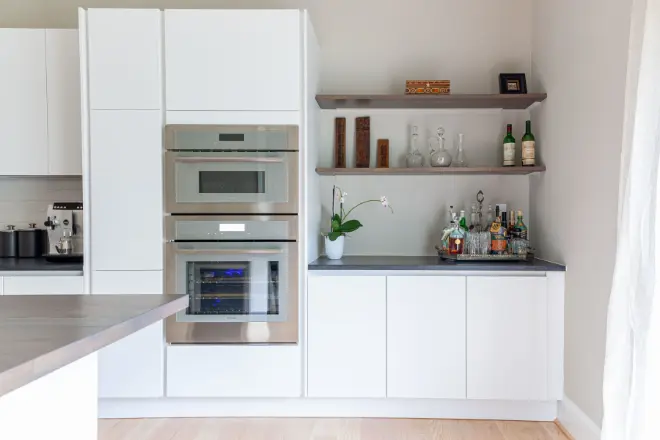
A Fresh Spin on Kitchen Updates Have you ever found yourself staring at your kitchen appliances, wondering if it's time for an upgrade? Or maybe...
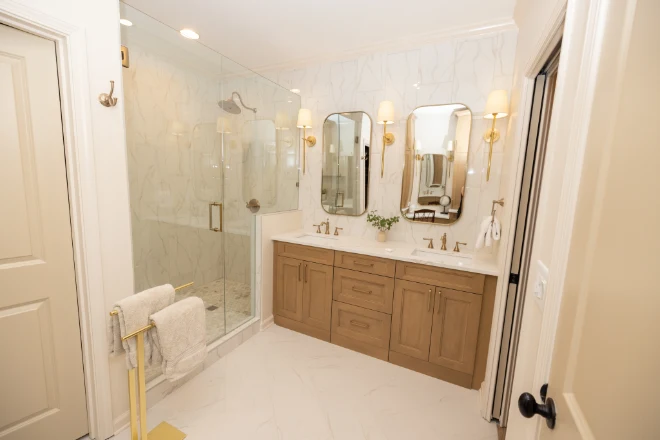
11 min read
Lighting Your Way to a Dream Bathroom Ever stood in your bathroom and thought, "Why does my vanity lighting make everything look so... off?" Or...
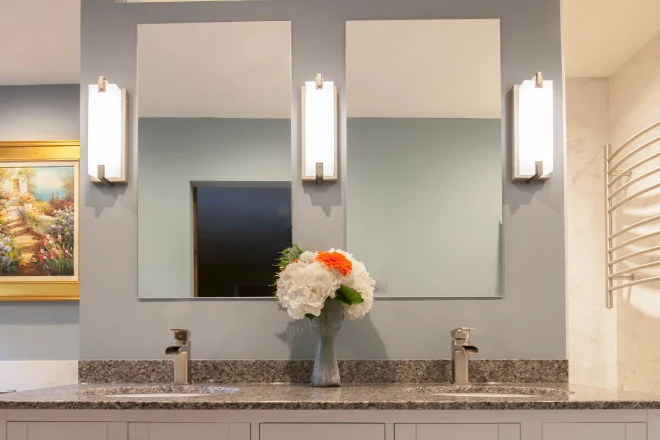
13 min read
Illuminating Insights Ever felt the frustration of not having enough light while getting ready in your bathroom? Or marveled at how a friend's...
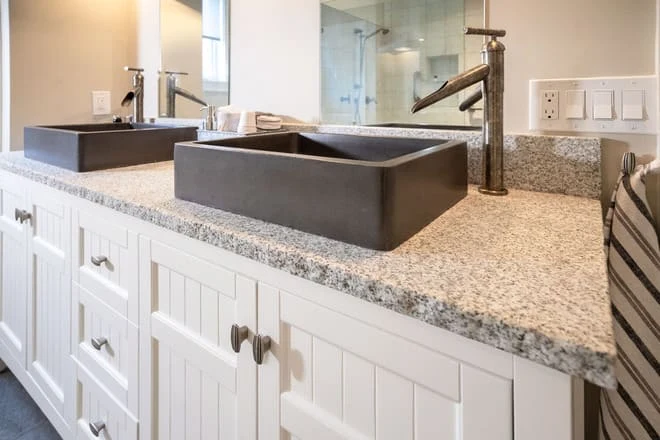
12 min read
Are you tired of your outdated bathroom countertop and ready for a fresh, modern look? Overwhelmed by the vast array of countertop materials...